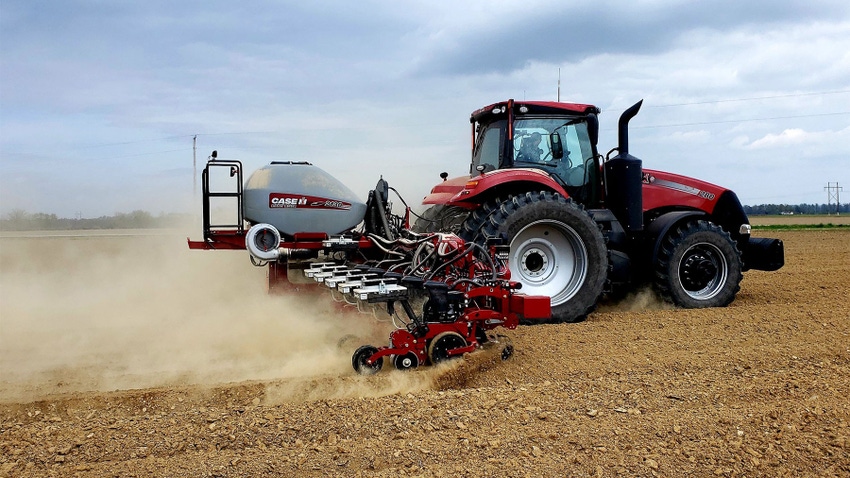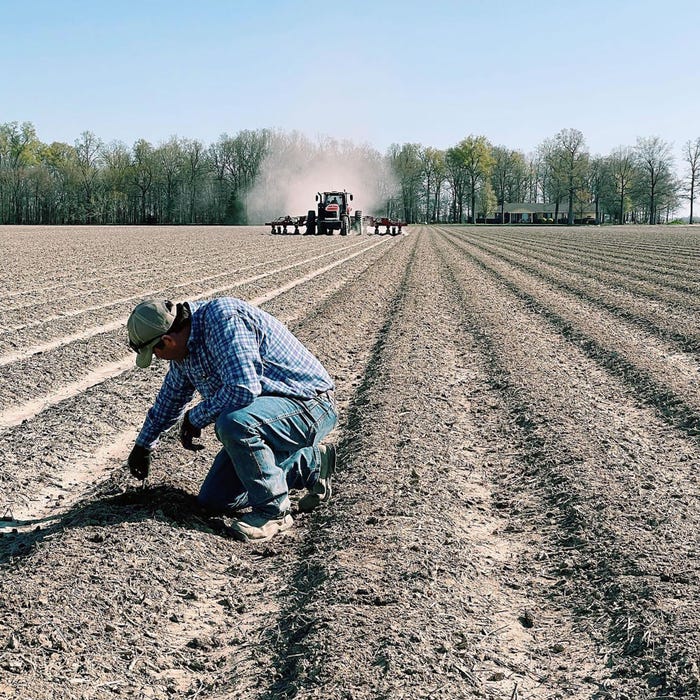
Popcorn in the field needs a lot of tender, loving care because if the quality of the crop isn’t up to par, it won’t pop to its full potential.
For Zack Tanner, president of Fancy Farm Popcorn at Bernie, Mo., that extra attention to his specialty crop starts at planting. He farms about 7,500 acres of popcorn, rice seed and soybeans with his wife, Rebekah, and sons, Zachary and Luke. So, the Tanner family pays a lot of attention to keeping the crop on schedule.
“Planting in early April versus May allows the popcorn to pollinate before the hottest temperatures arrive, and it allows us to get our rice and soybeans in on time,” Tanner explains. “We’re trying to get a lot done in a short period of time.”
Speed is imperative at planting to get the crop in on time and stay on schedule. For that, Tanner relies on the latest technology.

PLANTER CHECK: Zack Tanner checks his planter depth and spacing by getting out of the cab and digging up the dirt.
Technology drives production
The family started with older planters, varying speeds from 5 mph to 5.7 mph, that tracked percent accuracy and skips at planting. It was time consuming.
Today, they have a 2130 Case IH high-speed planter. “We can run nine, 10 or even 11 mph, all while achieving 9.5% accuracy with 100% ground contact,” Tanner says.
He monitors the planters remotely via a smartphone, watching what is going on in the cab and viewing its screens to check accuracy.
“Then, I’m on the ground, basically ground-truthing what is happening with the planter, so we can keep things moving,” Tanner says.
Last year, they planted at 11 mph. “That was our highest-yielding farm,” he adds. “Plus, the central fill of this planter makes refilling so much quicker with longer run times between fill-ups.”
Focus on emergence
As with field corn, Tanner focuses on even emergence and spacing, noting it is more crucial when planting popcorn.
If popcorn doesn’t emerge consistently, he explains, the crop can produce a smaller ear on some plants and a larger ear on other plants. Varied ear size won’t thresh as evenly and will shell more, adding to header loss.
“If you have equal spacing and depth,” Tanner says, “you will have equal emergence and equal ear size.”
When speed and accuracy are so crucial, Tanner says that this is one way they can control the quality of the grain they are harvesting, processing and selling to customers.

QUALITY PRODUCT: The Tanner family owns Fancy Farm Popcorn, a business the family started in 1987. Today, they sell popcorn kits that ship straight from the farm to customers’ doors.
Moving business forward
The family founded their popcorn company, Fancy Farm Popcorn, in the 1980s.
“We had to figure things out through the school of hard knocks,” Tanner explains. “We were adding value-producing seed for soybeans, wheat and rice and growing corn, sending it to the elevator. Popcorn allowed us to make use of our corn acres.”
Initially, their crop went to movie theaters and grocery stores. Today, most of their popcorn is sold as a packaged kit — including popcorn, coconut oil and salt, going to various concession customers.
They’ve been producing the kits since the mid-1980s, and they were one of the first companies to invent these packets and perfect the process, Tanner says. The packets keep the quality of the popped corn consistent, no matter who is popping it. The company also markets popcorn through bulk and truckloads of totes containing 50-pound bags.
“We believe that if you can’t do it right, don’t do it at all,” Tanner adds. “Our crew of dedicated employees have absolutely perfected the kits, particularly the package layout.”
Learn more about Fancy Farm Popcorn at fancyfarmpopcorn.com.
About the Author(s)
You May Also Like






